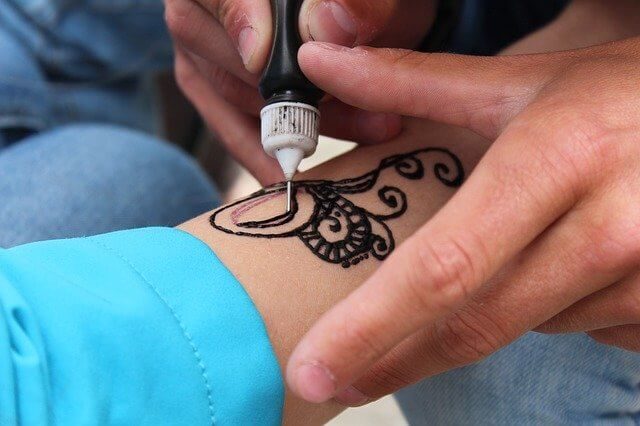Just for Men
Just for Men is a line of hair color and other personal care products marketed specifically toward men. The product line includes dyes and shampoos designed to color gray hair. Just for Men products are manufactured by Combe, Inc. and have been sold in the United States since 1987.

Potentially thousands of men have experienced severe reactions after using Just for Men brand hair dye. Symptoms may include swelling, skin irritation, blisters and burns to the skin. Severe reactions may result in anaphylaxis.
Reactions to Just for Men, allergic or otherwise, have frequently been blamed on one of its ingredients — p-Phenylenediamine, or PPD. PPD is widely used in hair dyes and is a major cause of hair dye allergies, according to the American Contact Dermatitis Society.
The number of hair dye reactions blamed on Just for Men has increased dramatically since 2014.
From 2004 through 2013, there were at least 25 adverse events associated with Just for Men dyes reported to the U.S. Food and Drug Administration. But the number doubled to 51 reports from 2014 to March 2019.
This information comes from the U.S. Food and Drug Administration’s CAERS database which includes side effects and complications related to cosmetic products. The reports come from consumers, health care providers and voluntarily reported data from the cosmetics industry. The reports can sometimes give early warning of problems with consumer products.
The FDA points out that the reports do not necessarily indicate that the product was the cause of any side effect or injury. But few people may be aware they can report problems to CAERS. That could also indicate the reports show only a fraction of possible reactions.
Some consumers who had used the product for months or years without a problem have suspected a sudden reaction was due to a change in Just for Men’s formula. But the company has said the formula has not changed since the mid-2000s. People can also develop sensitivity to PPD even after several previous reaction-free uses.
An increase in number of reported hair dye reactions may also be due to increased popularity of hair coloring among both men and women, according to DermNet NZ, a New Zealand-based dermatology website. In the U.S., the spike has spurred Just for Men lawsuits.
What is p-Phenylenediamine (PPD)?
PPD is a chemical ingredient that reacts inside individual hair fibers to create a natural-looking hair color when it’s exposed to oxygen. When combined with p-Aminophenol, another ingredient in Just for Men, the combination turns a shade of dark brown. Other ingredients in differing amounts can adjust the color to a range of shades from sandy blond to black.
Most two-bottle-type hair dyes rely on PPD for color. It’s also present in tints and rinses. It’s popular because it is a permanent dye that provides a natural look. It can also be shampooed or permed without losing color.
Is PPD Safe?
PPD is generally safe to use as long as you follow the instructions included with Just for Men or other hair dyes containing the chemical.

Your chance of a reaction to PPD increases if you have ever had a black henna tattoo. The temporary tattoos often contain high levels of PPD and may sensitize your body to the chemical. That means your body may produce an allergic or immune response the next time you come in contact with PPD.
How to Patch Test Just for Men for a Possible Hair Dye Reaction
Patch testing involves applying a small amount of the dye to your skin and waiting to see if there is a reaction. Even if you’ve used the same hair dye multiple times, you should test each time to make sure you have not developed an allergy to it since the last use.
Patch testing is the “gold standard” in determining whether you have a PPD allergy or whether it is safe for you to use Just for Men. The instructions included with Just for Men dyes starts off with patch testing instructions.
Just for Men recommends applying a small amount of the dye to a coin-sized patch of skin on the inside bend of your elbow.
How to Patch Test for Hair Dye Allergy
- Wash with soap and water
- Pat dry
- Mix a small amount of dyes from each of the two bottles
- Reseal both bottles
- Apply the mixture with a cotton swab to the skin
- Do not wash or cover the test patch of skin for 48 hours
If you do not have a skin reaction after 48 hours, the dye is generally safe to use.
Side Effects and Serious Reactions
The number of people testing positive for PPD allergies has been increasing, according to a 2017 study in the Journal of Asthma and Allergy.
Reactions may happen several hours to days following exposure to the chemical in hair dyes. Reactions seldom affect the scalp, but affect skin on the face, neck and ears that may be exposed to PPD.
Typical Symptoms of PPD Hair Dye Reactions
- Stinging or burning sensation on the scalp, face, eyelids, ears or neck
- Severe itching
- Swelling of the skin
- Blisters, welts or weeping sores
- Contact dermatitis (rash)
- Permanent skin discoloration
- Disfiguration
- Rash on the forehead, neck or side of the face
If you have a reaction to PPD, you are likely to have a lifelong sensitivity to the chemical. That means you will continue having reactions each time you come in contact with PPD.
Serious Reactions to PPD
While most reactions happen where PPD makes direct contact with the skin, there have been reports of more serious reactions that can affect organs or whole body systems.
The U.S. Environmental Protection Agency warns many of these conditions can happen from short-term exposure to PPD.
Symptoms of Acute Short-Term Exposure to High Levels of PPD
- Asthma
- A narrowing of the airways making it difficult to breathe
- Gastritis
- Inflammation of the protective lining of the stomach
- Renal failure
- Reduced function of the kidneys
- Vertigo
- Sense of spinning or dizziness, usually the result of problems in the inner ear or brain
- Tremors or convulsions
- Involuntary movements or spasms due to abnormal signals in the brain
- Coma
- A state of prolonged unconsciousness
Preventing and Treating PPD-Related Reactions
If you have a reaction to Just for Men or any other hair dye containing PPD, you should stop using it immediately. You should also avoid other products containing PPD. Continuing to use them can make your next reaction even worse.
You should also be aware of other products you use containing chemical ingredients similar to PPD. You may experience reactions to these products as well.
Substances Related to PPD that May Also Cause Allergic Reactions
- Azo dyes
- Found in semi-permanent or temporary hair dyes, ballpoint pen ink, used to color foods and certain medicines, textiles
- Benzocaine and procaine
- Used as a local anesthetic by doctors and dentists
- Medications
- Certain medicines including sulfonamides, sulfones, sulfa drugs and para-aminosalicylic acid
- Para-aminobenzoic acid
- Commonly called PABA, this is used in sunscreens and cosmetics. Look for PABA-free labeling to avoid it
Let your doctor and dentist know that you have had a PPD reaction, since medicines and anesthetics they may prescribe or use could trigger an allergic reaction.
Treatments for PPD Reactions
If you have an allergic reaction to Just for Men or other PPD hair dyes, you should stop using it. If you experience dermatitis, you should try to neutralize the PPD in your hair.
Wash the area with a soap substitute to remove excess dye and apply hydrogen peroxide or potassium permanganate solutions according to a study in the Journal of Asthma and Allergy.
Steroid creams or oral antihistamines may relieve some of the symptoms. But severe reactions may require hospitalization.
PPD Hair Dye Alternatives
PPD-free hair dyes include indigo and vegetable-based products. Pure henna dyes are another alternative, but make sure there is no PPD added.
Be sure to read any hair dye label carefully. There are several different versions of PPD, and it may be listed as any of those names.
Alternative Names for PPD on Hair Dye Labels
- PPDA
- 1,4-Benzenediamine
- 1,4-Diaminobenzene
- Phenylenediamine base
- 4-Phenylenediamine
- 4-Aminoaliline
- P-Diaminobenzene
Also check for other closely related chemical ingredients that may cause the same or similar reactions if you are sensitive to PPD.
Closely Associated Chemicals to PPD
- P-Toluenediamine
- P-Aminodiphenylamine
- 2,4-Diaminoanisole
- o-Aminophenol
- p-Aminoazobenzene
Avoiding all of these chemical ingredients can prevent future allergic reactions to PPD. But you may still have allergic reactions to PPD-free hair dyes.
About 10 percent of people allergic to PPD are also be allergic to semi-permanent, PPD-free dyes. About half the people who are allergic to PPD dyes can use dyes with para-toluenediamine sulfate, or PTDS. You should conduct a patch test with any new dye you try.
If you have your hair colored at a salon, advise your hairdresser of any PPD reaction you have experienced.
12 Cited Research Articles
Consumernotice.org adheres to the highest ethical standards for content production and references only credible sources of information, including government reports, interviews with experts, highly regarded nonprofit organizations, peer-reviewed journals, court records and academic organizations. You can learn more about our dedication to relevance, accuracy and transparency by reading our editorial policy.
- American Contact Dermatitis Society. (n.d.). Paraphenylenediamine. Retrieved from https://www.contactderm.org/files/public/Patient%20Handouts/ZZ%20PARAPHENYLENEDIAMINE.pdf
- Johnson, J. (2018, January 5). What You Should Know About Hair Dye Allergies. Medical News Today. Retrieved from https://www.medicalnewstoday.com/articles/320505
- Combe, Inc. (n.d.). Just for Men Original Formula Instructions. Retrieved from https://justformen.com/pub/media/pdf/JFM_Original_Formula_EngSpFr.pdf
- Di Justo, P. (2008, June 23). What’s Inside: ‘Just for Men’ Hair Color. Wired. Retrieved from https://www.wired.com/2008/06/st-justformen/
- Mukkanna, K.S., Stone, N.M, and Ingram, J.R. (2017, January 18). Para-phenylenediamine allergy: current perspectives on diagnosis and management. Journal of Asthma and Allergy. Retrieved from https://www.ncbi.nlm.nih.gov/pmc/articles/PMC5261844/
- Nelson, D. (2012, October 22). ‘Just for Men’ Hair Dye Users Report Allergic Reactions. Consumer Affairs. Retrieved from https://www.consumeraffairs.com/news04/2012/10/just-for-men-hair-dye-users-report-allergic-reactions.html
- Ngan, V. and Gomez, J. (2018). Allergy to Paraphenylenediamine. DermNet NZ. Retrieved from https://dermnetnz.org/topics/allergy-to-paraphenylenediamine/
- U.K. National Health Service. (2018, July 23). Hair Dye Reactions. Retrieved from https://www.nhs.uk/conditions/hair-dye-reactions/
- U.S. Environmental Protection Agency. (2000). p-Phenylenediamine. Retrieved from https://www.epa.gov/sites/production/files/2016-09/documents/p-phenylenediamine.pdf
- U.S. Food and Drug Administration. (2019, July 2). CFSAN Adverse Event Reporting System. (CAERS). Retrieved from https://www.fda.gov/food/compliance-enforcement-food/cfsan-adverse-event-reporting-system-caers
- Whelan, C. (2019, March 1). Hair Dye Allergy. Healthline. Retrieved from https://www.healthline.com/health/hair-dye-allergy
- Williams, M. (2019, February 22). Orlando man used Just for Men to dye his beard. Lawsuit says he's now permanently scarred. Orlando Sentinel. Retrieved from https://www.orlandosentinel.com/news/breaking-news/os-ne-just-for-men-lawsuit-20190222-story.html
Calling this number connects you with a Consumer Notice, LLC representative. We will direct you to one of our trusted legal partners for a free case review.
Consumer Notice, LLC's trusted legal partners support the organization's mission to keep people safe from dangerous drugs and medical devices. For more information, visit our partners page.
844-420-1914